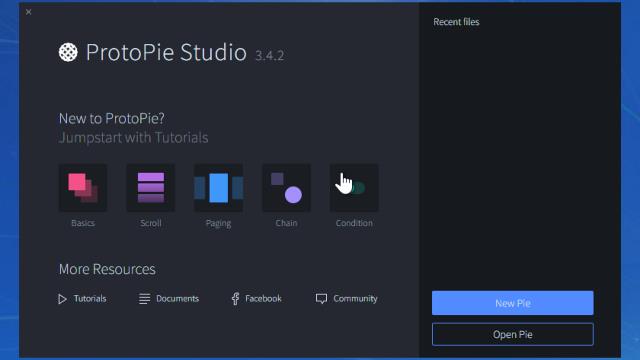
- #PROTOPIE LOADING ANIMATION HOW TO#
- #PROTOPIE LOADING ANIMATION FULL#
- #PROTOPIE LOADING ANIMATION SOFTWARE#
It is fair for Adobe to rely on their wonderful ecosystem of products like Photoshop and Illustrator for the design aspect but in my opinion they need to provide more powerful interaction and animation tools. Pioneering solutions Axure and Balsamiq have a hard time catching up because they focus on functionality rather than user-workflow and experience.Īt the other end of the spectrum, solutions like Adobe XD do really well in the execution – they are solid, fast and reliable, but they fall short in the available feature set (basic stroke styles or on hover behaviors). On paper, solutions like JustinMind, Anima and Supernova have it all but they fall short in execution – by being slow and unstable. The primary take away from my study is that features are not everything! Subjective criteria (Micro interactions, Macro interactions, etc.): I am hoping your experience and needs are not too far from mine… Photoshop, Sketch, After Effects, Invision, html+css… are no strangers to me.Objective criteria (price, platform, features and so on): Keep in mind that the features listed grow more rapidly than I can write.Rating the Design tools objectively and subjectively In order to be impartial, I gave myself 1 hour to download, learn and reproduce as much as possible of a reference prototype (See above).
#PROTOPIE LOADING ANIMATION FULL#
Some focus on prototyping, others on full design > prototype > collaboration workflow.Īs the use cases are quite broad, it is almost impossible to conduct a fair comparison on them. They don’t all operate in the same space.
#PROTOPIE LOADING ANIMATION SOFTWARE#
I’ve decided to save you some time and provide a little tour of the software tools’ landscape. Specifically, if you’re interested in product design, there are many options available … which also means it can be hard to keep up. Having the right tools for the right Steve (joke) is more important than ever. “You cannot mandate productivity, you must provide the tools to let people become their best”-Steve Jobs. Maybe you make your prototypes using the same old tools and don’t have much time to look for alternatives? Learn more about state transitions and animations.You want to make your screens interactive but don’t know where to start? This interaction (triggered when the prototype shows the particular screen) will cause a change of screen state from State 1 (initial) to State 2, through the transition specified.

In the example described above that comes from the Sample Project, the interaction is placed on the screen ('Placing Order') as seen in the image below: 'On Screen Show' -> 'Change Screen State' of 'Placing Order' to 'State 2'.

This can be achieved through a relevant 'Change Screen State' or 'Change Container State' interaction, applied on a screen or a UI component. Note: Although you will be able to preview the transition in the timeline, it has to be triggered in your prototype for it to play. That's it! You successfully created a simple but impressive transition. You can see the preview directly on the canvas. Use the controls (Play > ) to preview your transition. But you can modify that by dragging the 'end' handle to the right or left (example shows the duration extended to 1.5s). By default the duration of the transition created for you is 250ms.

Here you can modify various settings concerning the UI items and their properties that take part in the transition. You will see the transition timeline open.

In the modal that pops up, just click CREATE to create the transition from State 1 to State 2. You will see the progress bar appear as full.Ĭhange to the STATE TRANSITIONS tab (next to SCREEN STATES). Viewing State 2 in the canvas, select the Progress bar and change the 'Progress (%)' setting to 100. State 2 is identical to State 1 initially. Then duplicate this state, to create State 2. Make sure that in the Progress bar properties, 'Progress (%)' is set to 0. In the example, we've also added an image and some text. You first need a screen with a State 1, in which you include a progress bar UI component from the iOS 9 Library. This can be found in the Sample Project available for importing in your Dashboard.
#PROTOPIE LOADING ANIMATION HOW TO#
This example will explain how to create a simple animation (state transition in Proto.io terms) like the one seen below, where a progress bar goes from empty to full.


 0 kommentar(er)
0 kommentar(er)
